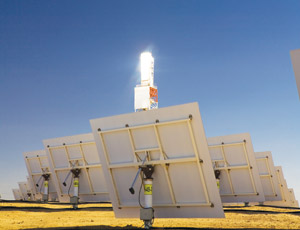West Coast solar power could get a major boost if the California Energy Commission approves as many as six of 13 proposed utility-scale solar projects in Southern California’s Mojave Desert by year-end.

At a series of meetings in October and November, the CEC will consider authorizing construction for some of the largest solar installations since 354 MW went online in the 1990s. An additional 3,500 MW of capacity—an estimated $18 billion worth of installed capacity—could be added, testing recent advances in solar-trough and concentrating-thermal-power-tower technologies.
To qualify them for stimulus funds, the Bureau of Land Management (BLM) and the CEC fast-tracked six of the projects on Mojave Desert public land through state and federal environmental approvals.
BrightSource Energy is proposing a 400-MW Ivanpah Solar Electric Generating System in San Bernardino County using solar-concentrating thermal towers. A total of 214,000 heliostat mirror pairs, sitting on dual-tracking axes that reflect sunlight onto a boiler atop three 459-ft towers, would heat water to a gaseous state at 1,000� F, thereby powering a steam generator in a closed loop. This project may be approved at a CEC meeting on Oct. 12.
Also on the October 12 CEC agenda is another San Bernardino project, the 850-MW Calico Solar Project (formerly the Stirling Energy Systems Solar One Project). When both phases are completed in about 44 months, the project could include 34,000 solar-receiver heat exchangers, called SunCatchers, in groups of 60, with closed-cycle engines that convert solar power to rotary power to drive electrical generators. Stirling, a subsidiary of Houston-based Tessera Solar, also has proposed a 750-MW SunCatcher project in Imperial County.
On Oct. 18, the CEC will consider the proposed 45-MW Chevron Lucerne Valley photovoltaic plant, which could include as many as 360,000 thin-film compound cadmium-telluride solar modules.
Unlike the 250-MW Beacon Solar Energy project—on private land in Kern County using 1,400 acre-ft of recycled water per year to cool thermal parabolic troughs and approved in August—the two thermal trough projects planned for BLM land use no water to convert sunlight to electricity. “Wet cooling is more efficient, but it has environmental impacts,” explained Cara Libby, project manager at the Palo Alto, Calif.-based Electric Power Research Institute (EPRI), a non-profit.
Technology Advances
Parabolic-trough technology has advanced greatly in the last two decades. Curved mirrors still are used to focus heat on a fluid-filled tube, which in turn heats water to steam to power a turbine generator. Today’s troughs are larger and have improved receiver-tube coatings, more efficient heat absorption and more durable mirrors.
Solar Millennium LLC, based out of Oakland, Calif., partnered with Chevron Energy Solutions of San Francisco to propose the 1,000-MW solar-thermal parabolic-trough Blythe Solar Power Project in Riverside County.
Juno Beach, Fla.-based NextEra Energy Resources is behind the 250-MW parabolic-trough solar-thermal project known as Genesis Solar. Scheduled to be discussed at a CEC meeting on Nov. 3, the project will consist of two independent, concentrated solar-electric-generating facilities in Riverside County.
Some projects have taken longer than expected to get through the process or have been withdrawn or reduced due to environmental concerns about the desert tortoise and other endangered species, said David Bryery, BLM spokesman. “Projects that have thought ahead about how they will be perceived by the environmental community are moving through the process faster,” said EPRI’s Libby.
If these projects are successful, it could be the beginning of a wave, said Libby. More than 4 gigaWatts have been proposed for California, with 10 gW nationwide. “What actually gets built will be dependent largely on regulatory uncertainty and availability of incentives,” Libby said.



Post a comment to this article
Report Abusive Comment